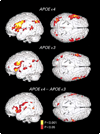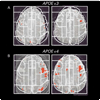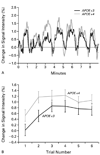Patterns of brain activation in people at risk for Alzheimer's disease
- PMID: 10944562
- PMCID: PMC2831477
- DOI: 10.1056/NEJM200008173430701
Patterns of brain activation in people at risk for Alzheimer's disease
Abstract
Background: The epsilon4 allele of the apolipoprotein E gene (APOE) is the chief known genetic risk factor for Alzheimer's disease, the most common cause of dementia late in life. To determine the relation between brain responses to tasks requiring memory and the genetic risk of Alzheimer's disease, we performed APOE genotyping and functional magnetic resonance imaging (MRI) of the brain in older persons with intact cognition.
Methods: We studied 30 subjects (age, 47 to 82 years) who were neurologically normal, of whom 16 were carriers of the APOE epsilon4 allele and 14 were homozygous for the APOE epsilon3 allele. The mean age and level of education were similar in the two groups. Patterns of brain activation during functional MRI scanning were determined while subjects memorized and recalled unrelated pairs of words and while subjects rested between such periods. Memory was reassessed in 14 subjects two years later.
Results: Both the magnitude and the extent of brain activation during memory-activation tasks in regions affected by Alzheimer's disease, including the left hippocampal, parietal, and prefrontal regions, were greater among the carriers of the APOE epsilon4 allele than among the carriers of the APOE epsilon3 allele. During periods of recall, the carriers of the APOE epsilon4 allele had a greater average increase in signal intensity in the hippocampal region (1.03 percent vs. 0.62 percent, P<0.001) and a greater mean (+/-SD) number of activated regions throughout the brain (15.9+/-6.2 vs. 9.4+/-5.5, P=0.005) than did carriers of the APOE epsilon3 allele. Longitudinal assessment after two years indicated that the degree of base-line brain activation correlated with degree of decline in memory.
Conclusions: Patterns of brain activation during tasks requiring memory differ depending on the genetic risk of Alzheimer's disease and may predict a subsequent decline in memory.
Figures



Comment in
-
Detection of preclinical Alzheimer's disease.N Engl J Med. 2000 Aug 17;343(7):502-3. doi: 10.1056/NEJM200008173430709. N Engl J Med. 2000. PMID: 10944568 No abstract available.
References
-
- Small GW, Rabins PV, Barry PP, et al. Diagnosis and treatment of Alzheimer disease and related disorders: consensus statement of the American Association for Geriatric Psychiatry, the Alzheimer’s Association, and the American Geriatrics Society. JAMA. 1997;278:1363–1371. - PubMed
-
- Price JL, Morris JC. Tangles and plaques in nondemented aging and “preclinical” Alzheimer’s disease. Ann Neurol. 1999;45:358–368. - PubMed
-
- Braak H, Braak E. Neuropathological staging of Alzheimer-related changes. Acta Neuropathol (Berl) 1991;82:239–259. - PubMed
-
- Saunders AM, Strittmatter WJ, Schmechel D, et al. Association of apolipoprotein E allele epsilon 4 with late-onset familial and sporadic Alzheimer’s disease. Neurology. 1993;43:1467–1472. - PubMed
-
- Corder EH, Saunders AM, Strittmatter WJ, et al. Gene dose of apolipoprotein E type 4 allele and the risk of Alzheimer’s disease in late onset families. Science. 1993;261:921–923. - PubMed
Publication types
MeSH terms
Substances
Grants and funding
LinkOut - more resources
Full Text Sources
Other Literature Sources
Medical
Miscellaneous
